Wild Alaska Bird Photography Tour Report 2023
11 July 2023


































































































Short-eared Owl, Saint Paul Island (Image by Mike Watson)

Red Phalarope, Utqiagvik (Image by Mike Watson)

Polar Bumblebee on a Net-leaf Willow catkin, Saint Paul Island (Image by Mike Watson)

Tufted Puffin, Saint Paul Island, bad hair day! (Image by Mike Watson)

Lesser Yellowlegs, Anchorage (Image by Mike Watson)

Arctic Lousewort, Saint Paul Island - one of several species of this Arctic plant seen on the tour (Image by Mike Watson)

Tufted Puffin, Saint Paul Island, showing its fishing tackle (Image by Mike Watson)

Least Auklet, a sparrow-sized alcid (Image by Mike Watson)

Dunlin in flight at Utqiagvik (Image by Mike Watson)

Tufted Puffin, Saint Paul Island (Image by Mike Watson)

Semipalmated Sandpiper on ice, Nome (Image by Mike Watson)

Red Phalarope, Utqiagvik (Image by Mike Watson)

Least Auklet, Saint Paul Island (Image by Mike Watson)

King Eider male, Utqiagvik (Image by Mike Watson)

Red Phalarope, Utqiagvik (Image by Mike Watson)

Spectacled Eider, Utqiagvik (Image by Mike Watson)

Red-legged Kittiwake, Saint Paul Island (Image by Mike Watson)

Spectacled Eider, Utqiagvik (Image by Mike Watson)

Pacific Loon, Anchorage (Image by Mike Watson)

Pacific Wren, Saint Paul Island (Image by Mike Watson)

Ross’s Alpine butterfly, Nome (Image by Mike Watson)

Bluethroat adds an extra splash of colour to the Bering Tundra at Nome (Image by Mike Watson)

Red-necked Stint at Utqiagvik (Image by Mike Watson)

Red Knot by the Nome to Teller Highway (Image by Mike Watson)

Spectacled Eider, Utqiagvik (Image by Mike Watson)

Rock Sandpiper, Saint Paul (Image by Mike Watson)

Rock Ptarmigan by the Nome to Teller Highway (Image by Mike Watson)

Western Sandpiper, Utqiagvik (Image by Mike Watson)

White-winged Scoters, Nome (Image by Mike Watson)

Spectacled Eider threesome, Utqiagvik (Image by Mike Watson)

Least Auklet flock at Antone Wall, Saint Paul Island (Image by Mike Watson)

Musk Ox, Nome (Image by Mike Watson)

Tufted Puffin, Saint Paul Island (Image by Mike Watson)

Semipalmated Plover (Image by Mike Watson)

Least Auklet in flight (Image by Mike Watson)

Red Phalarope, Utqiagvik (Image by Mike Watson)

Least Auklet, Saint Paul Island (Image by Mike Watson)

Steller’s Sea Lion, Saint Paul Island (Image by Mike Watson)

Red-legged Kittiwake, Saint Paul Island (Image by Mike Watson)

Saint Paul town (Image by Mike Watson)

Friendly Least Auklets on Saint Paul Island (Image by Mike Watson)

Steller’s Eider, Utqiagvik – becoming ever scarcer (Image by Mike Watson)

Pec (Pectoral Sandpiper) Wars, Utqiagvik (Image by Mike Watson)

Willow Ptarmigan, female, Kougarok Road (Image by Mike Watson)

Least Sandpiper, Saint Paul Island (Image by Mike Watson)

Aleutian Tern incoming (Image by Mike Watson)

Baird’s Sandpiper does a nice flypast at Utqiagvik (Image by Mike Watson)

Black Brant over the Arctic Tundra at Utqiagvik (Image by Mike Watson)

Snow Bunting, AKA Barrow Sparrow (Image by Mike Watson)

Small groups of diminutive Least Auklets gather on a rocky beach at Saint Paul Island (Image by Mike Watson)

Red-necked Stint in full breeding plumage (Image by Mike Watson)

Tufted Puffin, Saint Paul Island (Image by Mike Watson)

Woolly Lousewort, Nome (Image by Mike Watson)

Tufted Puffin, Saint Paul Island (Image by Mike Watson)

Surfin’ Ancient Murrelets, Saint Paul Island (Image by Mike Watson)

Northern Shrike nest, Nome (Image by Mike Watson)

Red-necked Grebes on Lake Hood in Anchorage Red-legged Kittiwake, Saint Paul Island (Image by Mike Watson)

Red Phalarope, Utqiagvik the queen of the tundra! (Image by Mike Watson)

Long-billed Dowitcher, Utqiagvik (Image by Mike Watson)

The blue morph of Arctic Fox predominates at Saint Paul Island (Image by Mike Watson)

Pacific Loon, Anchorage (Image by Mike Watson)

Pectoral Sandpiper, Utqiagvik (Image by Mike Watson)

Pectoral Sandpiper, showing its rhinokinesis powers (Image by Mike Watson)

Long-billed Dowitcher, Utqiagvik (Image by Mike Watson)

Pomarine Jaegers are enjoying a lemming year at Utqiagvik (Image by Mike Watson)

A flight of Least Auklets (Image by Mike Watson)

The rare Emperor Goose at Safety Sound, Nome (Image by Mike Watson)

The arcticola subspecies of Dunlin is pretty impressive (Image by Mike Watson)

King Eider female, Utqiagvik (Image by Mike Watson)

Red Phalarope, Utqiagvik (Image by Mike Watson)

Red-legged Kittiwake, Saint Paul Island (Image by Mike Watson)

Red-legged Kittiwake, Saint Paul Island (Image by Mike Watson)

Least Auklet, the darkest breeding plumaged bird we saw (Image by Mike Watson)

Grizzly Bear by the Nome to Teller Highway, it was still winter up there (Image by Mike Watson)

The subtle beauty of Baird’s Sandpiper, an uncommon breeding bird at Utqiagvik (Image by Mike Watson)

Red-legged Kittiwake, Saint Paul Island (Image by Mike Watson)

Polar Bear on the beach in town at 4am at Utqiagvik (Image by Mike Watson)

Red-necked Stint habitat, Nome (Image by Mike Watson)

A gorgeous Horned Puffin at Ridge Wall, Saint Paul Island (Image by Mike Watson)

Woolly Lousewort landscape, Utqiagvik (Image by Mike Watson)

Snowy Owl, male at Utqiagvik (Image by Mike Watson)

Pacific Loons waiting for the tundra pools to thaw, Utqiagvik (Image by Mike Watson)

Red-necked Stint, Utqiagvik (Image by Mike Watson)

Red Phalarope, Utqiagvik (Image by Mike Watson)

Boreal Jacob’s Ladder, a pretty plant with a circumpolar distribution, we also see this one on Svalbard (Image by Mike Watson)

Musk Ox, Nome (Image by Mike Watson)

Northern Fur Seals, Saint Paul Island (Image by Mike Watson)

Rock Sandpiper, Saint Paul (Image by Mike Watson)

Red Phalarope, Utqiagvik, showing why it is known as ‘Broad-billed’ Phalarope in some countries (Image by Mike Watson)

Semipalmated Plover (Image by Mike Watson)

Pec (Pectoral Sandpiper) Wars 2, Utqiagvik (Image by Mike Watson)

Ancient Murrelets at Saint Paul Island, a nice bonus (Image by Mike Watson)

Curlew Sandpiper, in full breeding dress, a rare vagrant from Siberian (Image by Mike Watson)

Tufted Puffin, Saint Paul Island (Image by Mike Watson)

Snowy Owl in flight at Utqiagvik (Image by Mike Watson)

Arctic Fox is common along the coast at Saint Paul Island, this female was obviously nursing cubs! (Image by Mike Watson)
The name Alaska is derived from the Aleut name ‘Alyeska’, meaning ‘Great Land’, and there is indeed a lot of it! In fact, at 663,300 square miles, its area is larger than the next three US states combined (Texas, California and Montana)! Flying over the state on this tour, we got a great impression of a wilderness of 3 million lakes, endless forests, and snowy peaks, where the tiny population of three quarters of a million people barely makes a scratch. Although we mostly spent our time in lower-lying parts, we enjoyed a terrific first visit to the Great Land, photographing a very interesting selection of birds from the gold rush town of Nome to the Arctic tundra of Utqiagvik (formerly Barrow) and the spectacular seabird colonies of remote Saint Paul Island in the Bering Sea. Of many highlights, gorgeous Aleutian Terns danced over driftwood on windswept beaches at Nome, spectacular Spectacled and King Eiders lit up the icy tundra pools at Utqiagvik and perky Crested Auklets delighted on the cliffs of Saint Paul Island. Befitting its true wilderness status, Alaska has wild weather to match, and this often gets in the way of travel plans. We were lucky to only have one flight affected by weather, fog kept us on Saint Paul for an extra night and happily the following morning was a sunny one.
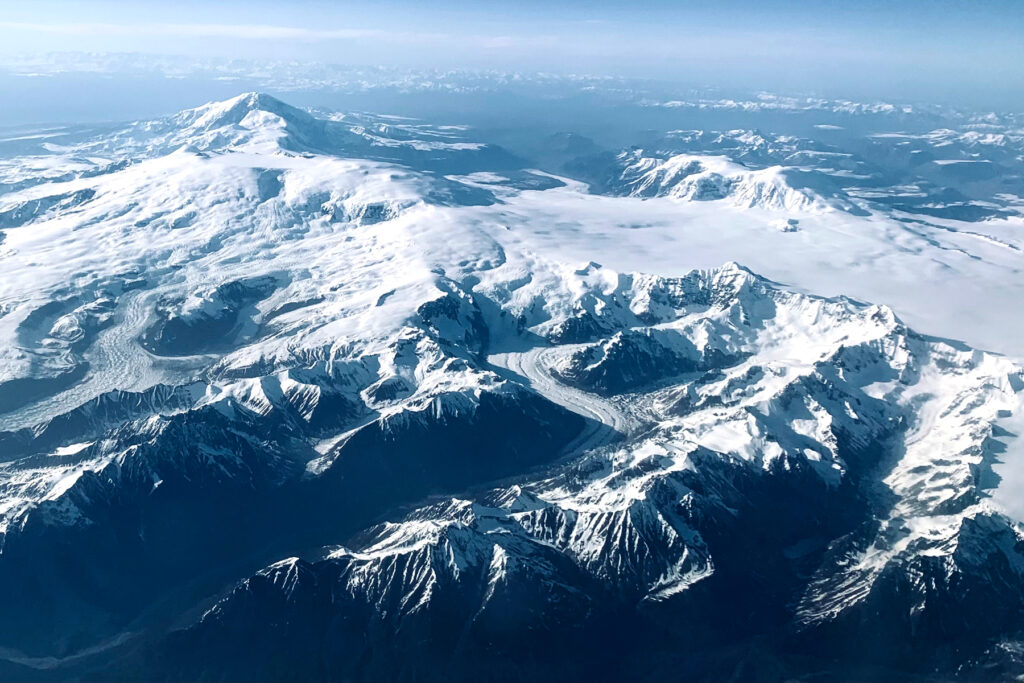
Denali from the sky (Image by Mike Watson)
Our itinerary consisted of three sections, Nome, and its environs, followed by a main tour, visiting the Utqiagvik tundra and then another extension, to Saint Paul, one of the Pribilof Islands, way out in the Bering Sea. There is no air service connecting these remote outposts (everywhere in Alaska is basically a remote outpost!) so we returned to Anchorage each time before flying to the next destination. Although it is the largest city by far, Anchorage is not actually the state capital of Alaska. That is Juneau, at almost 10% of the population of Anchorage it is also the only US state capital that is not accessible by road! Anchorage is the state’s main transport hub connected to many remote locations by air, however, not all of them have airstrips. Our hotel by Lake Hood has the distinction of being next to the busiest seaplane base in the world, with over 750 seaplanes based there. With frequent noisy landings and take-offs, you might think little Lake Hood would be devoid of birds but there were quite a few waterbirds around its fringe. Red-necked Grebes, Greater and Lesser Scaups, Ring-necked Duck, Barrow’s Goldeneye and American Wigeon were all photographable to an extent after our first evening meal. At only 61 degrees north, Anchorage does not enjoy midnight sun and what passes for night is more like twilight. The biggest factor, as we would come to experience in Alaska, is the extent of cloud cover to the west, which dictates whether you get that incredible golden light show.
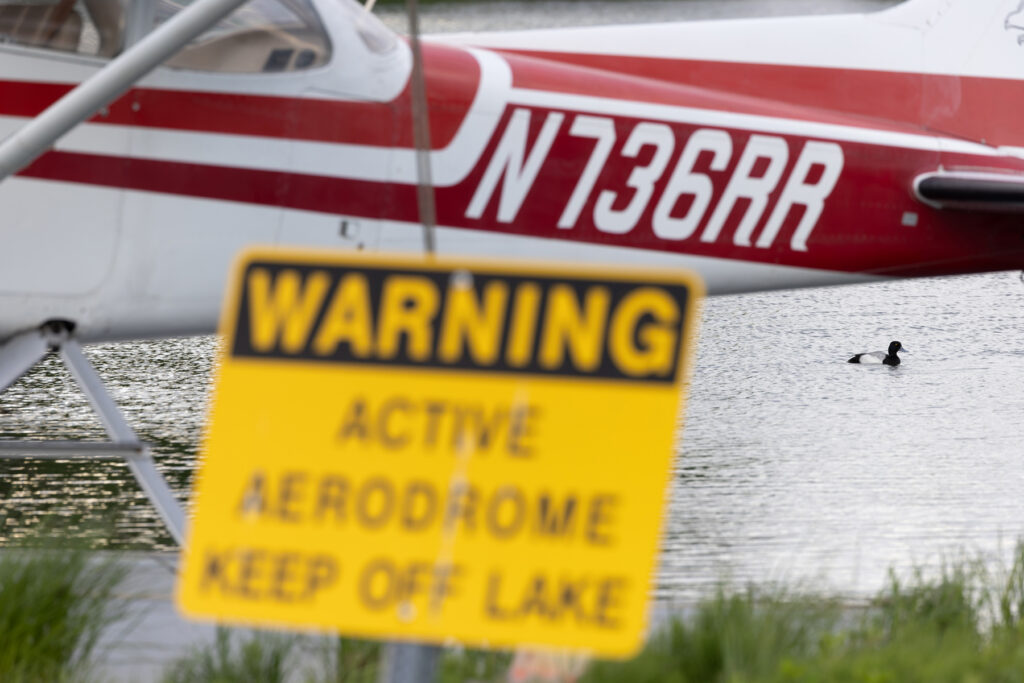
Greater Scaup trespassing at Lake Hood Aerodrome (Image by Mike Watson)
AFTER THE GOLD RUSH
Alaska doesn’t feel much like the USA. It was bought from Russia in 1867, for $7.2m, around 2 cents per acre. Prior to that it was a colony of Russia – the sale was thought to be an attempt to appease a potential ally against their enemy of the Crimean War, Great Britain, and at that time neighbouring Canada was not a country yet (although four of the British colonies were in the process of joining to form the Dominion of Canada). Almost 100 years later it was admitted to the union in 1959, becoming the 49th state of the USA. Back to the present day, we sat in the shiny Ted Stevens International Airport in Anchorage, waiting for our flight to Nome and listening to final calls to passengers bound for evocative sounding destinations like King Salmon.
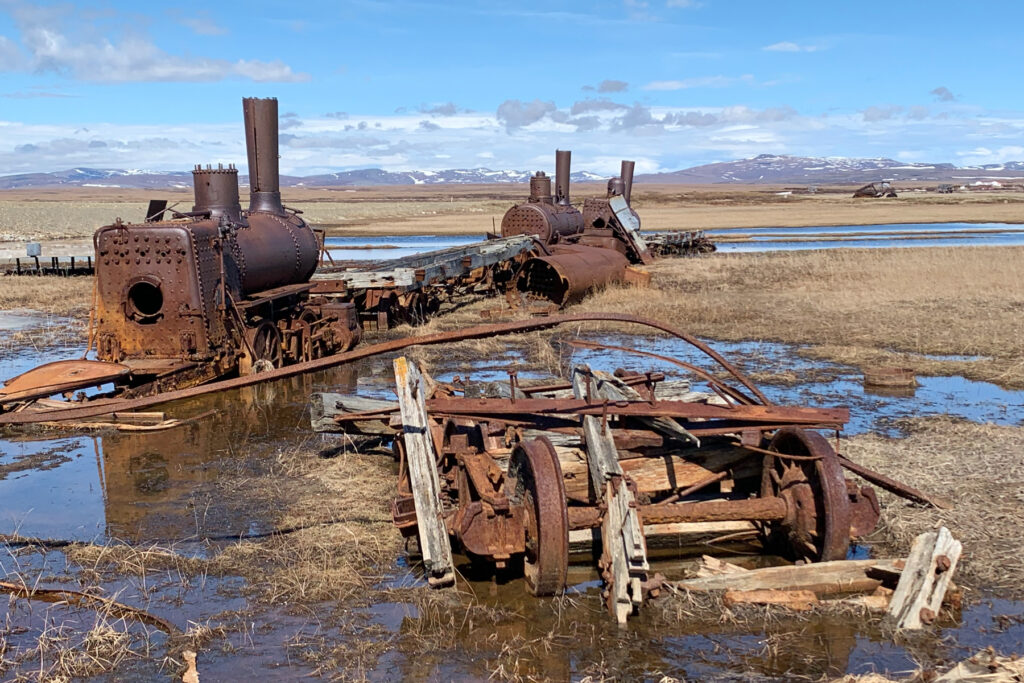
Last Train to Nowhere, iconic Gold Rush artefact at Nome (Image by Mike Watson)
Gold was discovered in Nome in 1898 and thanks to the ensuing rush, within one year it had a population of 10,000. More than three times the present population over 100 years later! There are still gold miners here, we met some of them at breakfast and could see their improvised diving boats off the beaches to the west of town. Nome is also famous as the finish line of the Iditarod Sled Dog race. The last section of the 1,000+ miles race follows the route taken by a team of dogs led by Alaskan Huskies Balto and Togo in 1925 to deliver a diptheria antitoxin serum to the native population of Nome, which was experiencing an epidemic at the time. It is famous among birders as the most accessible place in the world to see the rare and fast declining Aleutian Tern. There is a great selection of other arctic birds available around Nome. Although at 64 degrees, roughly the same as Reykjavik in Iceland, it lies south of the Arctic Circle but Nome still has an Arctic feel. We flew over masses of sea ice on our approach and less than a week prior to our arrival, Nome had received four inches of snow on 1 June! Spring 2023 was apparently the coldest for over 40 years. Exiting the airport terminal at Nome a White Wagtail flew over calling, we were close to Asia now! The Seward Peninsula is a mere 50 miles from Russia, across the Bering Strait and the region encompassing Alaska and Chukotka on the Russian side, sometimes known as Beringia, shares much fauna and flora.
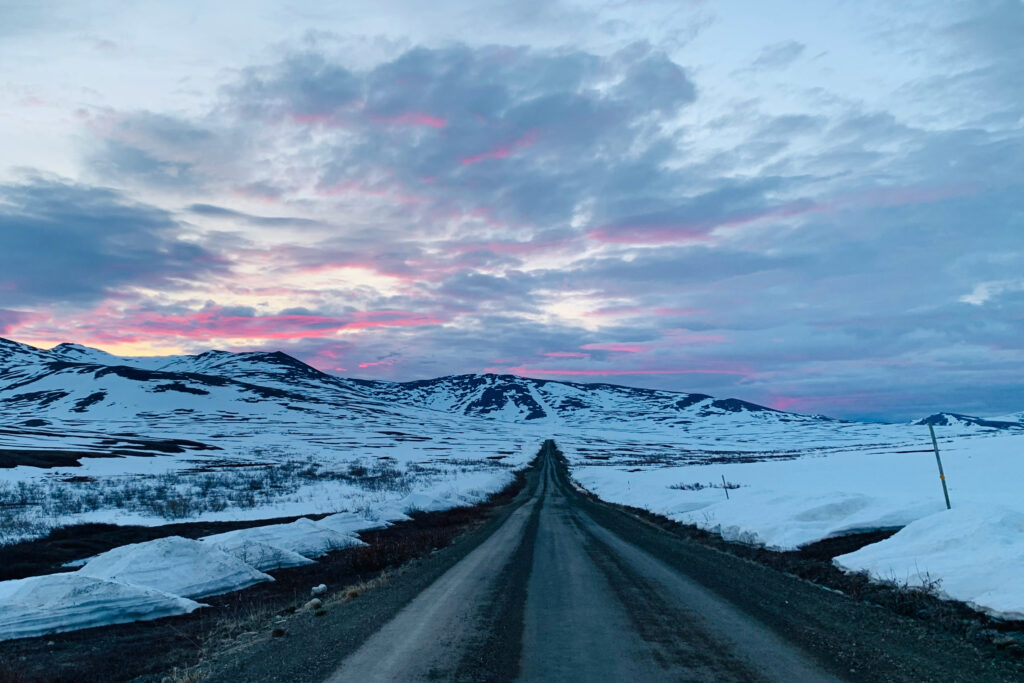
Kougarok Road, Alaska (image by Mike Watson)
We arrived at our hotel to read a headline in The Nome Nuggest (Alaska’s oldest newspaper, Nome was once the most populous town in Alaska!) that read ‘ADF&G dispatches rabid moose roaming through Teller’. This unfortunate animal had been terrorising residents in the next town, foaming at the mouth and charging at folks! The first case of rabies in a moose in Alaska, it was presumably bitten by a fox but happily it was almost 80 miles away from Nome. It was still a good reminder of the wild country we were now in. The front page of the Nome Nugget also featured of a Wolverine on a snowy ridge, recently spotted in the Kigluaik Mountains, where we would be heading the following day. This was all very exciting, and we dropped our bags at our hotel and headed out to the coast to look for birds.
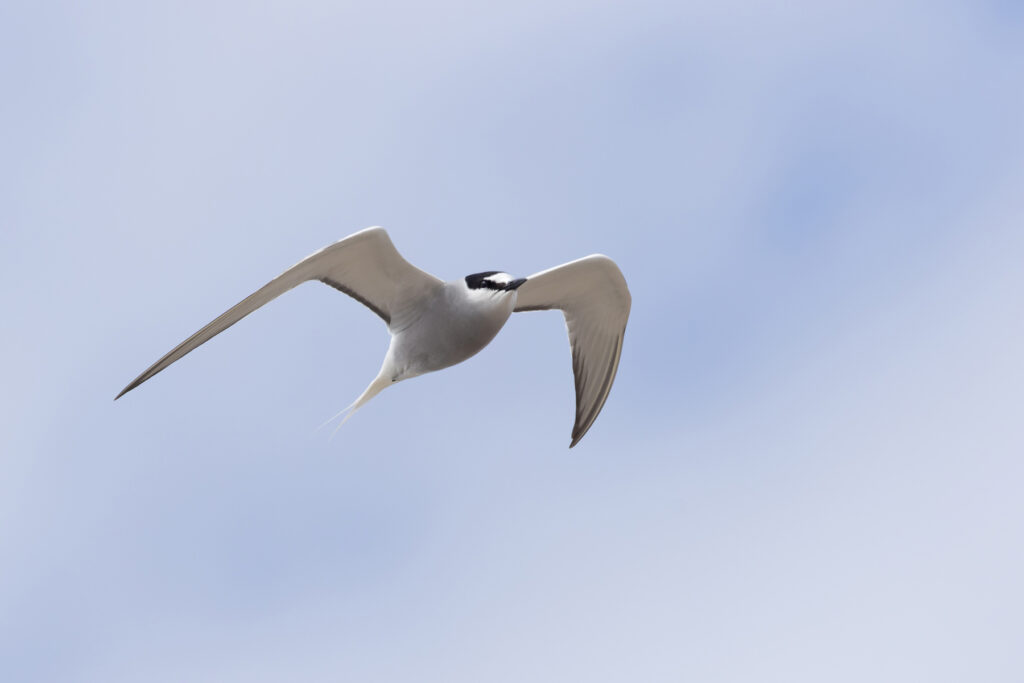
Nome is the most accessible place in the world to see the declining Aleutian Tern (Image by Mike Watson)
First on our list and the most important of all here was the smart Aleutian Tern. They were easily located at a nearby beach, flying back and forth to the sea. We kept our distance from where they appeared to be landing as they are very easily disturbed, although we later saw that the beach was regularly used by 4WD vehicles, so the terns had no chance of settling here. They did have other undisturbed options in the general area, and we were happy to settle for lovely some fly-bys, their odd chattering calls announcing their presence. It was impossible to say how many birds were involved but maybe as many as 10? What a great welcome to Nome! A few other birds were within camera range here including the much more common Arctic Tern, Red-throated Loon, Red Knot, Least Sandpiper, Black-legged Kittiwake, Glaucous and Short-billed Gulls and some redpolls. Other species noted that were a little out of reach of the lenses were Black Brant, Green-winged Teal, Harlequin and Long-tailed Ducks, American Golden Plover, Long-billed Dowitcher, Parasitic and Long-tailed Jaegers, Willow Ptarmigan and Eastern Yellow Wagtail.
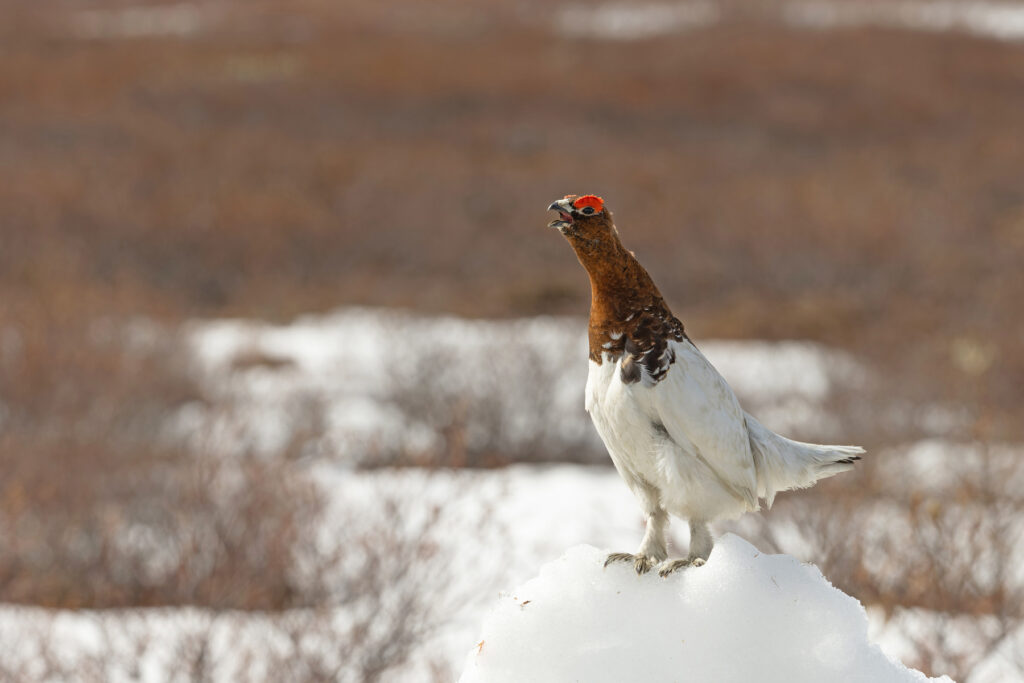
Willow Ptarmigan, male, Kougarok Road (Image by Mike Watson)
We ventured a little further along the coast, and it became apparent that there was some major sea defence construction happening, with an endless series of semis roaring along the coastal dirt road, laden with rocks and hardcore. They were repairing the damage caused by Typhoon Merbok, which crashed into the Alaskan coast on 17 September 2022. We added photos of Lapland Longspur and Semipalmated Sandpiper, both of which were breeding along the grassy shore of the vast Safety Sound lagoon. More distant sightings included Tundra Swan, Common Eider, Red-breasted Merganser, Sandhill Crane and Pacific Loon. With a long journey (by Nome standards!) ahead we went to bed early.
What’s this? Rain? I definitely didn’t order this. Added to the recent dump of snow this meant horrible road (if you can call it that) conditions in the interior. We set off at an unearthly hour up the Kougarok Road for our appointment with one of the rarest migrant birds in the world, Bristle-thighed Curlew. Our progress was painfully slow with drop-offs on both sides of a slippery ‘road’ surface. We were quite lucky that a wash out on the Kougarok had just been repaired a week earlier otherwise we would not have been able to get beyond about 25 miles outside town. It was in fact still closed a couple of miles beyond where we needed to get to at around 79 miles from Nome. To pass the time we counted Willow Ptarmigans and, later, Snowshoe Hares. The ptarmigans took an impressive lead, both finished over 70, the ptarmigans edging it with a total of 73 versus the hares’ 70. A couple of Rock Ptarmigans was new for the trip, but light conditions remained very grim. Other mammal highlights along the way, past occasional isolated fishing huts in the wilderness, were Musk Ox, beaver (two trotting along the snowbound road ahead of us plus another pair in a roadside channel) and Arctic Ground Squirrel. As forecast, the weather was gradually clearing as we headed north closer to our destination and the snowy winter landscape softened to brown moorland, somewhat reminiscent of the grouse moors of the Forest of Bowland near my home in East Lancashire but on a much grander scale.
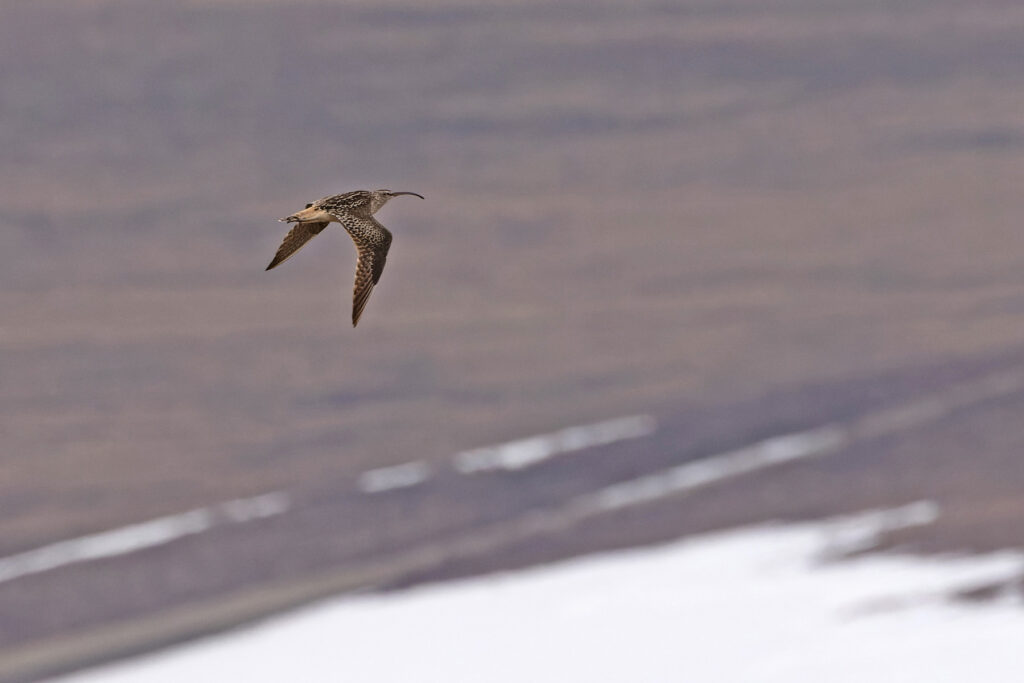
The rare Bristle-thighed Curlew in the mountains north of Nome (Image by Mike Watson)
We pulled up at the old boots that indicate the trailhead at the curiously named hill ‘Coffee Dome’ and began our hike up a very gentle incline, hardly believing we were in the correct spot that has been described as steep! In truth it is a very easy walk that anyone of normal fitness can do without being short of breath. We could already hear the wobbly whistling song of Bristle-thighed Curlew up ahead somewhere over the skyline. It is something of a lottery as to whether the curlew will land within range during its song flights, and we weren’t lucky. We did have some quite nice flight views though. Its commoner cousin Hudsonian Whimbrel was more accommodating. The curlews seemed to be sticking more to the area of shorter tussock-grass tundra, where plants like Woolly Lousewort, Purple Saxifrage and Mountain Avens were growing in the patterned ground. Also up here, we were able to photograph American Golden Plover, Western Sandpiper, Wilson’s Snipe, Long-tailed Jaeger, Lapland Longspur as well as couple of singing passerines – Savannah Sparrow and Orange-crowned Warbler. On the return to Nome, which was a little quicker in now drier road conditions, we enjoyed bird song in the patches of willows – Golden-crowned Sparrow, Northern Waterthrush and Grey-cheeked Thrush. Several skittish Rusty Blackbirds largely avoided the cameras. A Golden Eagle carried nesting material to a faraway crag and a couple of enormous cow Moose were noted, neither were photogenic though. One, with two small calves, had a huge neck collar and the other remained obscured by branches.
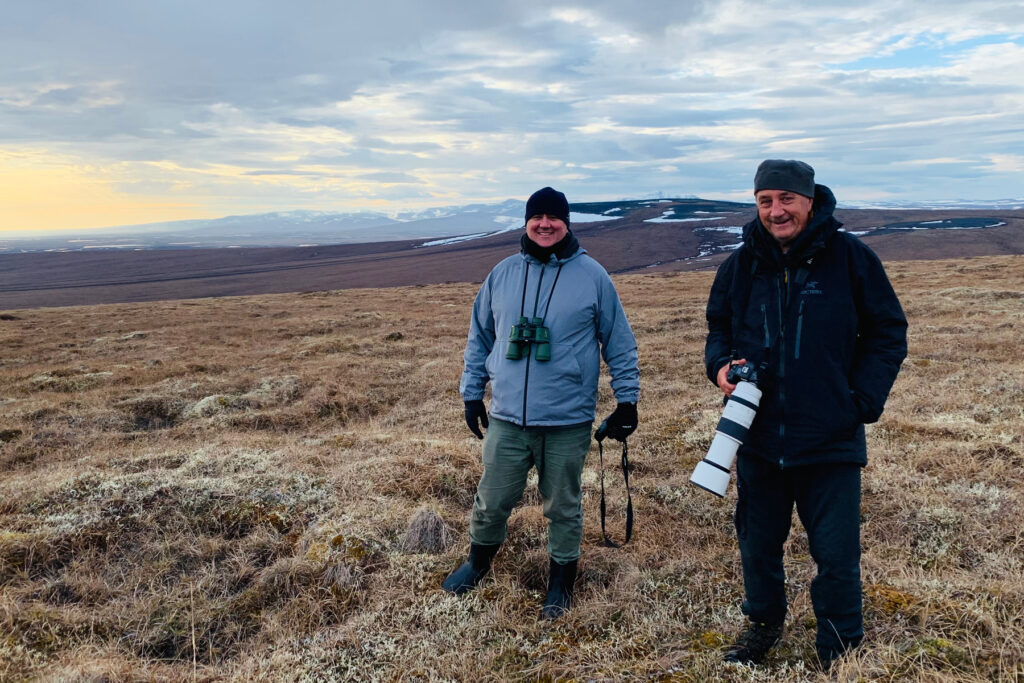
Wild Imagers at Coffee Dome, Nome (Image by Mike Watson)
The bird list also included a selection of waterfowl – Cackling Goose (Taverner’s), Greater White-fronted Goose, Tundra Swan, Northern Shoveler, American Wigeon, Northern Pintail, Green-winged Teal, Greater Scaup, Harlequin and Red-breasted Merganser – all of which were available for record shots. A few shorebirds were also noted – Semipalmated Plover, Least Sandpiper and Spotted Sandpiper plus Short-billed and Glaucous Gulls and Arctic Terns, all of which were breeding more than 60 miles inland. Back at Nome we saw a young Bald Eagle on the fence at the landfill, a small flock of Red-necked Phalaropes and a Long-billed Dowitcher along Beam Road and a couple of Long-tailed Jaegers.
For those able to keep their eyes open, there was an after-meal session along the coast which featured some very nice low angle sunshine at around 11pm, with dark storm clouds across the sea as a background. This was quite a nice scene for the Aleutian Terns as groups of White-winged Scoters passed by close inshore. We checked every single one from photos for Stejneger’s without any luck. At the creeks towards the cape, we enjoyed some close views of redpolls, including one Hoary/Arctic and a few Lapland Longspurs as well as Western Sandpiper, Red-necked Phalarope and Grey-cheeked Thrush. At the cape itself distant sea ducks transpired to include three Surf Scoters and around 15 Black Scoters with the White-winged and around 20 Harlequin Ducks. As the sun slipped into a final bank of cloud on the western skyline we went back to town, where there were some very close Musk Ox along Beam Road.
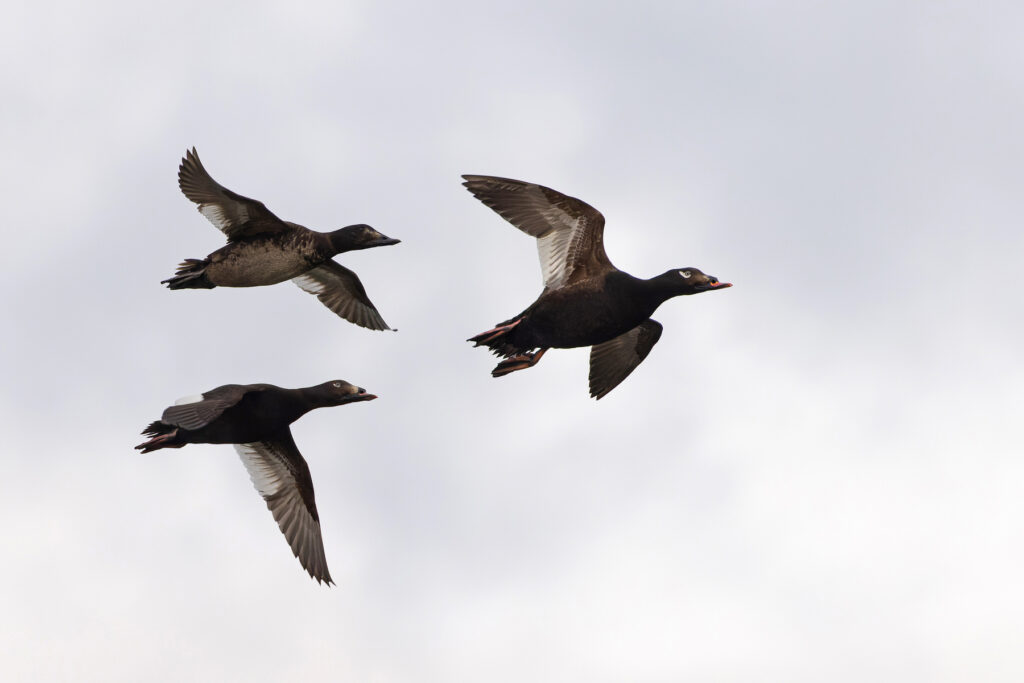
White-winged Scoters, Nome (Image by Mike Watson)
We were getting to know our temporary patch quite well now and today’s programme was a more extensive exploration of Safety Sound. After a very tasty breakfast at the world’s slowest café, we drove east, carefully checking many spots along the seashore and the inland side of the sand bar that separates the sound from the sea. Highlights included a group of four Emperor Geese, which afforded a nice fly past. Summertime iron-stained heads and all. They are uncommon at Nome, with an inaccessible breeding range along the north coast of the Seward Peninsula and further south in the Yukon Delta. Tundra Swan and Greater Snow Goose were also added to our memory cards but first prize this morning went to a Semipalmated Sandpiper on ice (they were also already on eggs in this area!), very nicely isolated against the white background. Further east at the famous Last Train to Nowhere, sharp-eyed Joseph spotted a tattler, which quickly transpired to be a Grey-tailed, a Siberian vagrant, more commonly found on the Pribilofs or Aleutian Islands. Finding one on the Alaskan mainland was a bonus. Unfortunately, it flew off east into the much wider tidal lagoon, giving its distinctive double note call as it went. Not before we got some nice photos though. The point-blank Red-necked Phalaropes here also occupied our photographers. Otherwise, photographable birds were very similar to our previous days’ forays adding only Semipalmated Plover (on a nest in the sand dunes), Dunlin of the very distinctive grey faced arcticola subspecies, some distant Sandhill Cranes and Parasitic Jaeger.
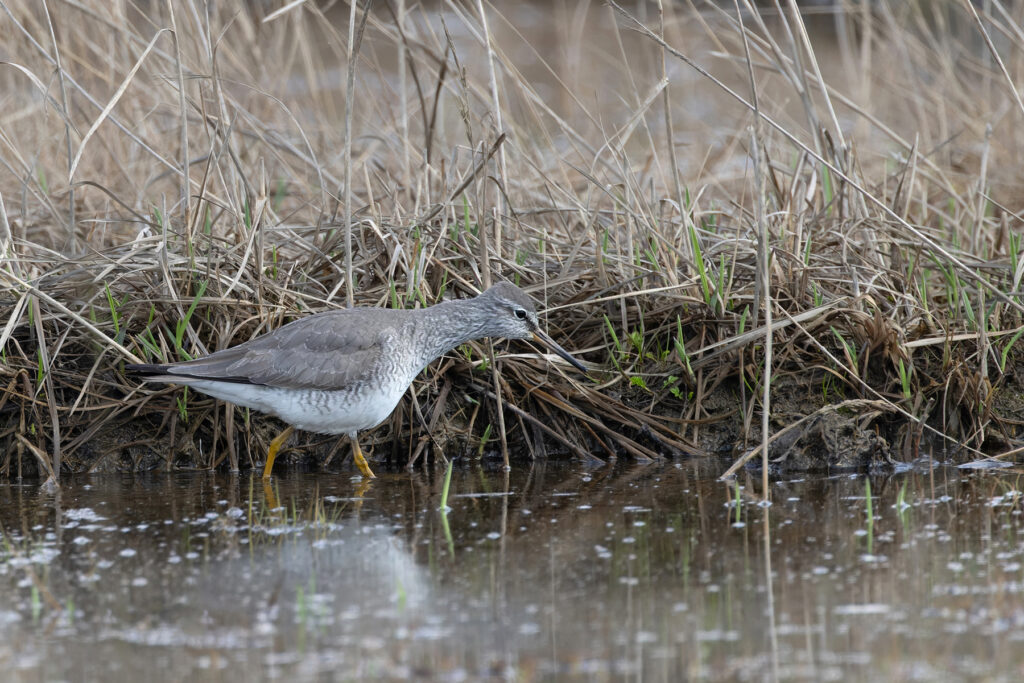
Grey-tailed Tattler, a Siberian vagrant waiting for the Last Train to Nowhere at Nome (Image by Mike Watson)
We continued inland towards Council where riverside willows produced a yellow warbler on a nest plus American Tree and White-crowned Sparrows in a now very harsh sunny haze. After evening meal, we attempted an evening session seeing the only butterfly of the whole trip – a lovely little Ross’s Alpine (a satyr or ringlet as we would call it back home) but a flat tyre (the only one of the tour, and only 5 minutes from the hotel!) took so long to fix that we called it a day. I’d been hoping for some spectacular butterflies on this tour but the spring was far too late this year to see any of them. Many of their food plants in the uplands were still under snow!
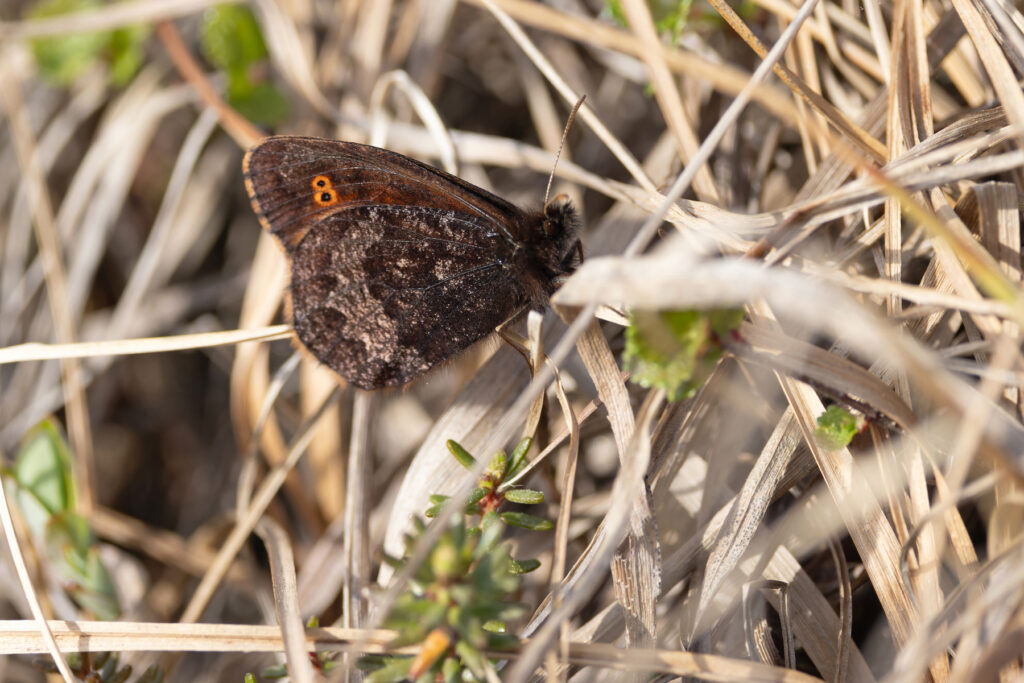
Ross’s Alpine butterfly, Nome (Image by Mike Watson)
On our last full day at Nome we ventured out on the third of the three roads that leave the town, the Nome to Teller (or Bob Blodgett) Highway. Highway must be some kind of joke, I’ve driven on better jeep tracks. However, the roads are so ravaged by the weather here every year that the use of tarmac is a waste of time and in fact it had only been open for two weeks after its winter closure. It took us what seemed like an eternity to get over 30 miles from town but eventually we reached our desired destination. Climbing a little higher onto some rocky tundra took us into a new habitat. Birds in this area included a couple of Merlins, Red Knot (a leg-flagged bird from a 2023 ringing scheme, data from which has yet to be registered so it will be interesting to see where it was flagged), Pacific Golden Plover and Rock Ptarmigan. Long-tailed Jaeger was particularly common in this area but again proved quite shy in front of the cameras. ‘Bear’ shouted Joseph! He generally made very good use of his days in the front seat! Sure enough, it was a Grizzly Bear, albeit a blonde one and a little out of range, uphill from the road but great to see, nevertheless. We were most definitely in bear country.
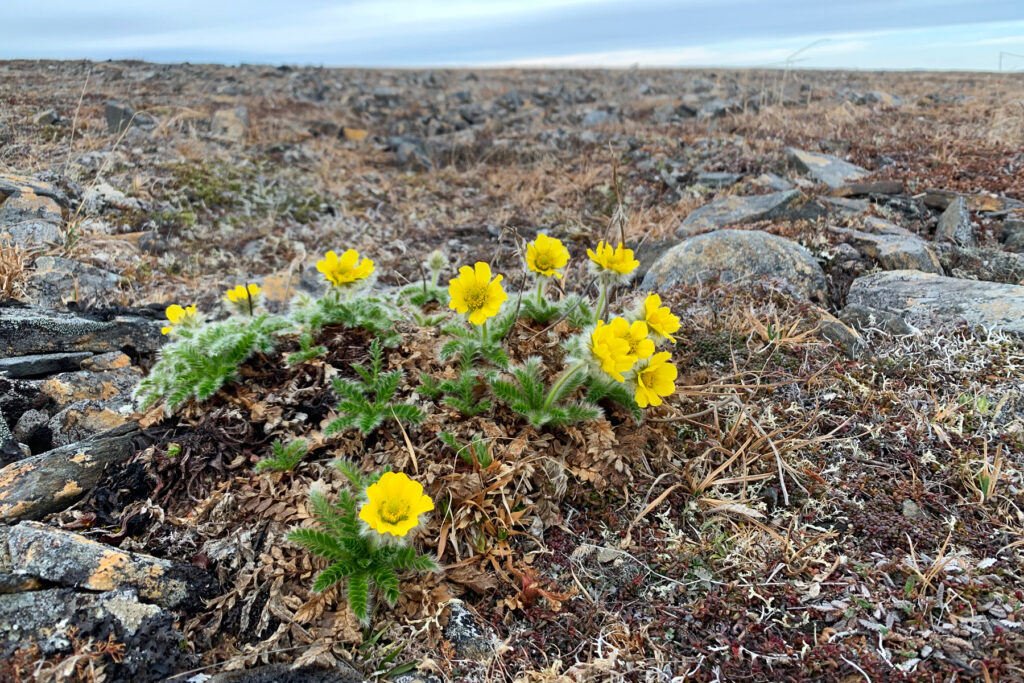
Glacier Avens by the Nome to Teller Highway (Image by Mike Watson)
A little later, one of our targets here was located, the gorgeous Bluethroat, basically a Eurasian species that just makes it into the North American continental side of Beringia. It was also quite shy and did not like to reveal its bright throat, but we had some quite nice views/in-the-landscape opportunities. On our return, a drake Eurasian Teal was another Siberian vagrant, and we could try our flight shot skills on Cliff Swallows breeding under the bridges across wide creeks that crossed the path of the ‘highway’. Also here were Tree Swallows and Sand Martins. Finally, we enjoyed some nice looks at Northern Shrike, first a natural sighting by the Penny River of a bird that appeared to be hunting American Robins! Second, was a much more surreal encounter with a pair nesting in Nome, in a small spruce in a front yard with kids playing in the street next to it! For the keen, the evening session included a sighting of three Spectacled Eiders (two drakes) just east of Cape Nome. They were horribly distant to start off with, not even identifiable through binos but eventually they decided to hop onto a large ice floe with some Common Eiders which drifted closer to the rocks of the cape, magic! No construction traffic this evening either, it was Saturday. We spent our final morning trying to recreate something like this but with little time it was not possible, the big one would just have to wait until we crossed the Arctic Circle. The rest of the day was mostly spent in airports and then the airport hotel back at Anchorage.
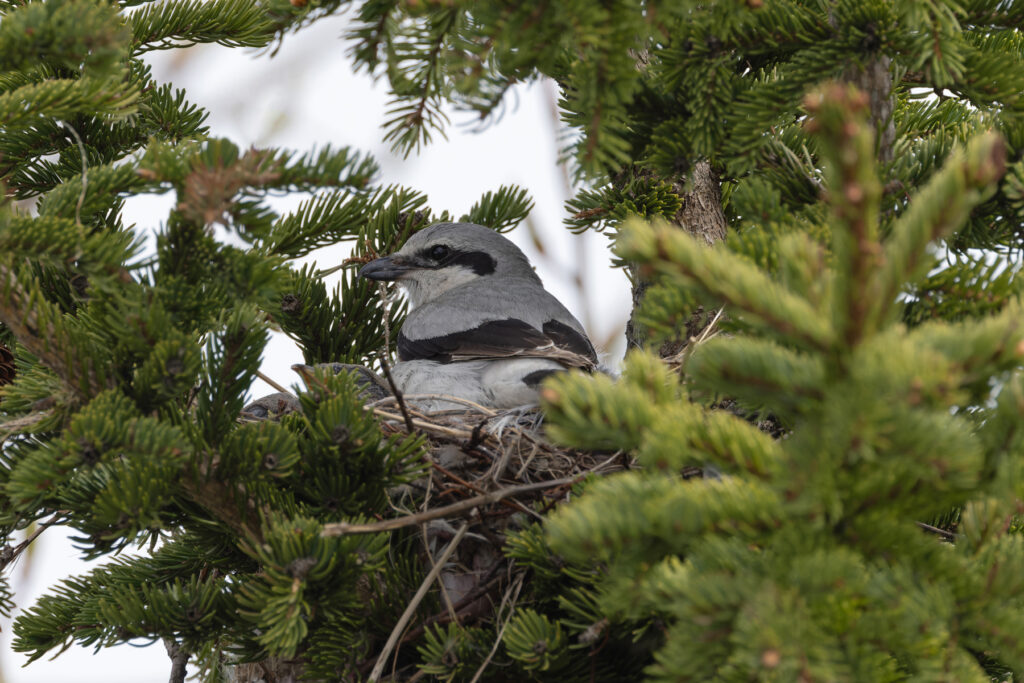
Northern Shrike nest, Nome (Image by Mike Watson)
And so, the main tour started with evening meal and then a fruitless walk along the Lake Hood shore in the twilight. However, next morning the sun was shining, and we had a little time before our flight north to Utqiagvik (still called Barrow on the airport notice boards of course). A stroll around a lovely forest bog lake produced some terrific views of the male of a pair of Pacific Loons against a very nice, uncluttered background at times. Thank goodness for the Canon R5’s flip screen, low angle shooting without laying down in the mud. While we were shooting it a surreal thing happened. A Lesser Yellowlegs landed next to the group and proceeded to walk right past along the water’s edge just inches away, completely unconcerned… and then it walked back in the opposite direction right past us again. It acted like some of the crazy juveniles you see in autumn but surely it must have seen people before? There were also some very nice looks at Short-billed Gull and Green-winged Teal from the same spot. Alder Flycatcher, Lincoln’s and White-crowned Sparrows sang from nearby trees. We also saw a couple of Moose here; they are very common in the Anchorage area!
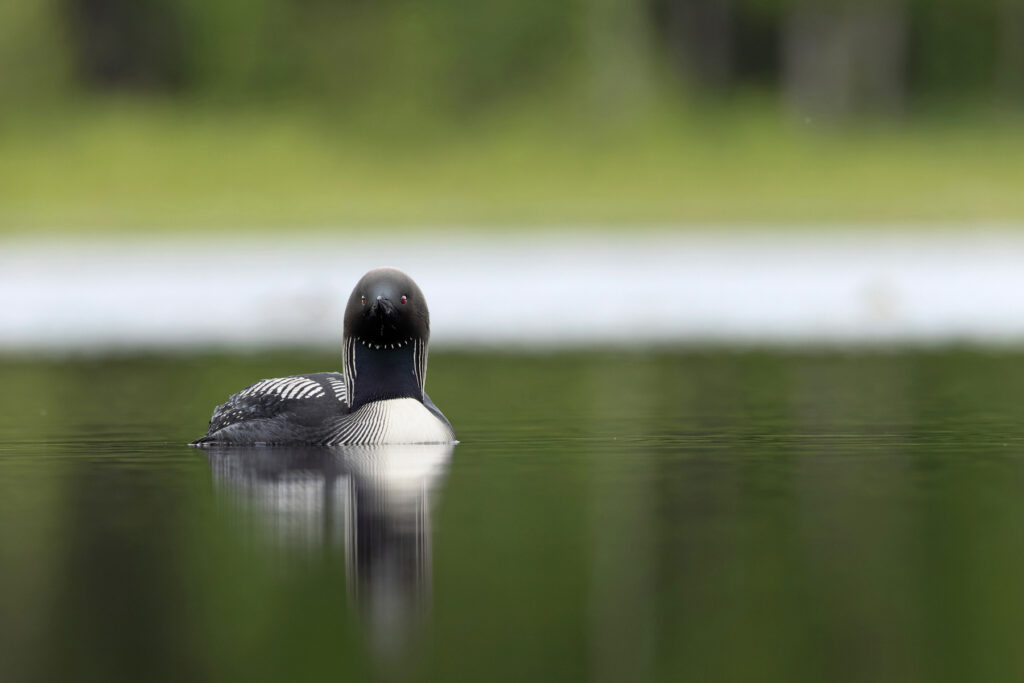
Pacific Loon, Anchorage (Image by Mike Watson)
TUNDRA WONDERS IN THE MIDNIGHT SUN
Flying north, we passed icing sugar-like snow-clad Denali, the green forests of the Yukon Valley and then the sharp peaks of the Brooks Range before the landscape turned brown over the tundra of the North Slope. At least one million lakes were interspersed by pingos and untamed meandering rivers, complete with zillions of ox-bow lakes and traces thereof. The lakes were mostly frozen with just the slimmest dark blue outlines where the water had started to melt. Then as we neared Utqiagvik, we crossed the broad border of sea ice pressed up against the coast – much more than usual in this cold spring. What a landscape! Having seen this, landing on the non-slip, grooved tarmac airstrip, we couldn’t wait to get started. A Snow Bunting was singing from the lamppost outside the terminal building as we navigated the free-for-all baggage reclaim chaos.
There is nothing like experiencing the tundra pools of Utqiagvik in spring. There are simply birds everywhere! We started our exploration of this special area along the strangely named Cake Eater Road (a derogatory term for wealthy people) and then out into the gas field. Utqiagvik is not a wilderness experience but there isn’t a more accessible place like it in the world for the sheer spectacle of tundra birds. It is a true world birding hotspot/Mecca. It was so strange to ignore hundreds of Red Phalaropes, a bird I normally spend hours looking for in Iceland and Svalbard, in favour of the even bigger prizes. The first eiders we spotted from the road was a pair of spectacular Spectacled Eiders, not far away in a partly frozen pool, which added another dimension to the background. Within a couple of days of warmer temperatures, the ice was gone and with the warmer temperatures came an infuriating heat shimmer. Although our dates revolved around what we thought would be the optimum time for Barrow we could not have timed our visit better for the eiders. Well, maybe one day earlier and we would have caught some of the 300 Yellow-billed Loons that flew over Utqiagvik but this was only a minor disappointment, it really is all about the eiders here. We enjoyed some nice views of Spectacled Eiders and added another two eider species with King and Steller’s but neither quite as good as the main attraction. There were other birds on the tundra! Black Brant, Greater White-fronted Goose and Long-tailed Ducks were quite common. Shorebirds were represented by lots of Pectoral Sandpipers, in addition to the Red and a small number of Red-necked Phalaropes; American Golden Plover, Semipalmated and Western Sandpipers and Long-billed Dowitcher. Both Pomarine and Parasitic Jaegers patrolled the skies along with the occasional Glaucous Gull. Loons were represented by Pacific and Red-throated on the few deeper pools and both Snow Buntings and Lapland Buntings sang nearby. A three-eider day and one of my favourites! However, it was now past midnight and into the next day.
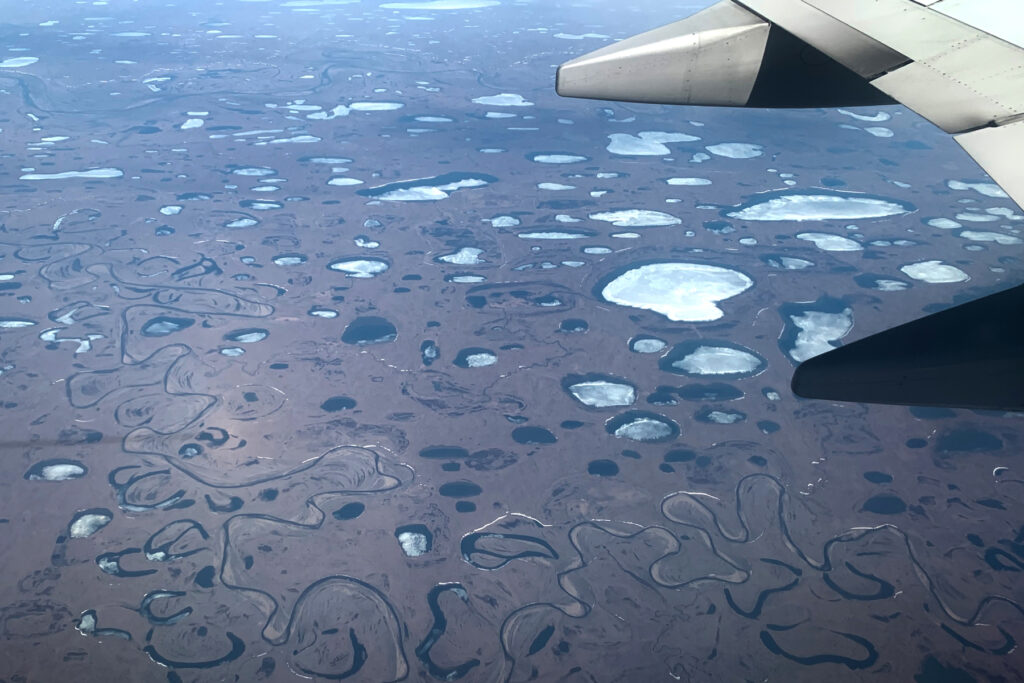
Arctic tundra at Utqiagvik (Image by Mike Watson)
Those who stayed up past midnight witnessed something special. We could see it happening while we were exploring back at the coast. The sun was going to reappear from behind clouds to the west and we hurried to the tundra pools. The pair of Spectacled Eiders was still in the same spot, and we were able to enjoy the most incredible light show as the tundra glowed in the golden low angle sunlight. Although we tried to recreate this moment on subsequent days, it did not happen again. The show was not quite over yet, I looked out of my hotel room window at just before 4am and there, on the ice, just off the beach was a huge Polar Bear! Joined for a while by another, eating whale meat put out by local people, it was still present at 7.45am for those heading to breakfast. What a day and a bit it had been at the top of the world.
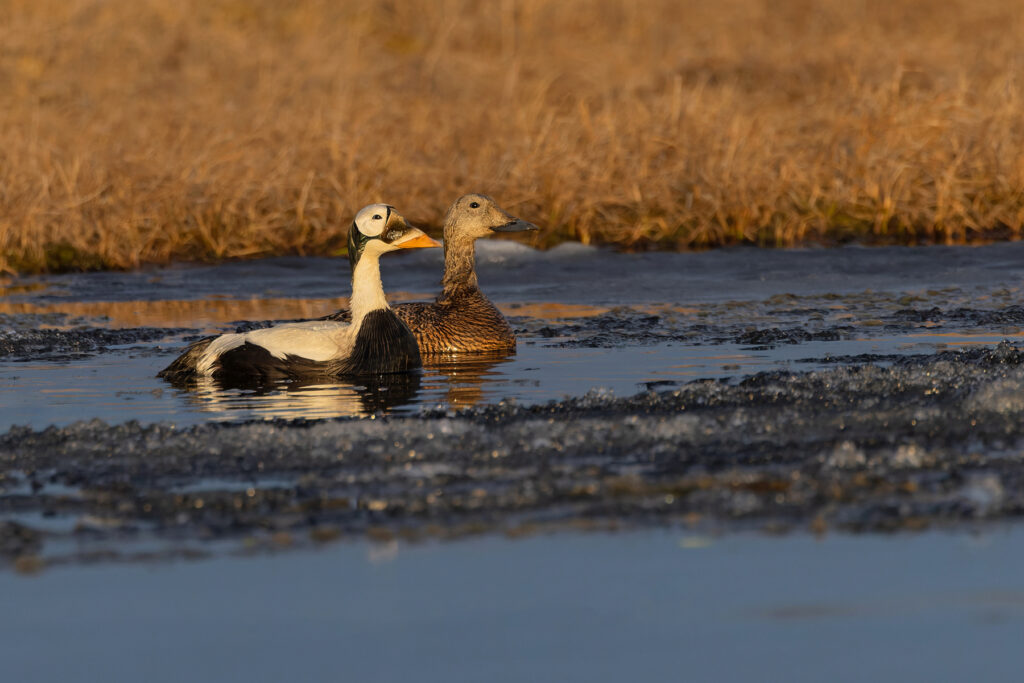
Spectacled Eider pair, Utqiagvik (Image by Mike Watson)
Utqiagvik is a phonetic spelling and means ‘The place where we hunt Snowy Owls’. The local people still hunt them to this day, for food and as a result they are rather shy. Next day we spotted one on the tundra to the south of town and typically it remained out of reach, flying great distances and perching across a wide snow-covered channel that would be too perilous to cross. It was obviously a lemming year, we saw them all over the place, including in the town, all Nearctic Brown Lemmings. It ought to be a good year for the predators that depend on them and in turn all the animals further down the food chain like shorebirds and waterfowl, whose young the predators turn to when lemmings are scarce will also benefit. We saw up to five Snowy Owls each day, invariably distantly but Pomarine and Parasitic Jaegers were also prominent during our visit. We were surprised to see a couple of each of Sand Martin and Barn Swallow the following day. Utqiagvik is known as the last stop on the line for wandering migrants.
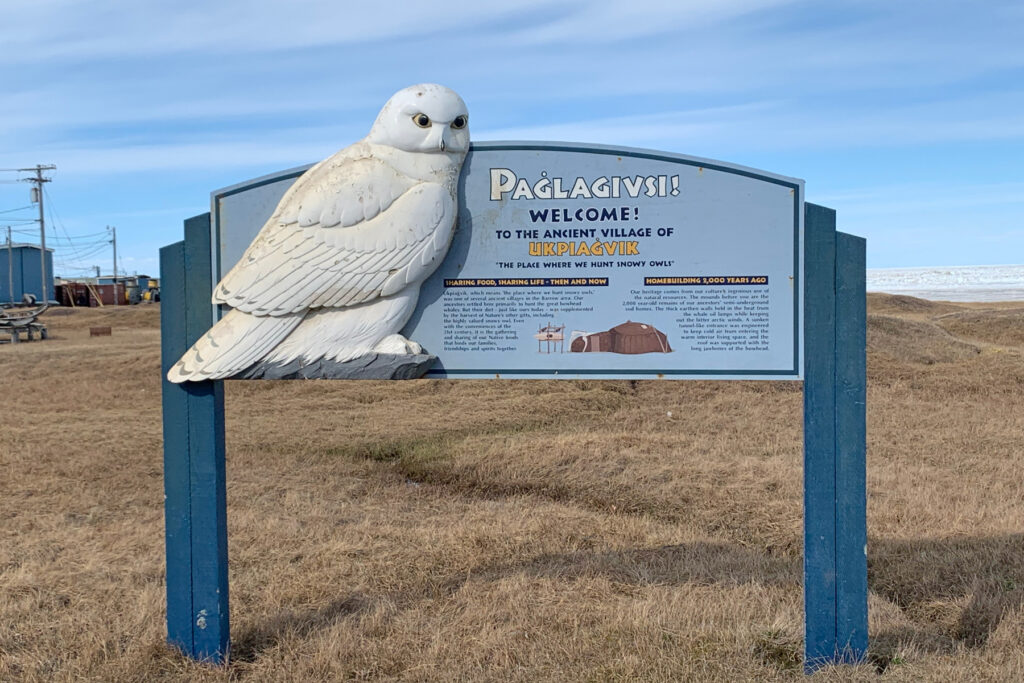
Utqiagvik, ‘The place where we hunt Snowy Owls’ (Image by Mike Watson)
We spent the following days catching up with some of the birds we did not have time for on day 1. King Eiders were quite numerous in a rather unsavoury spot near the town’s landfill and we managed a few images without plastic bags in the frame. In fact, we had a four-eider-day today! While photographing the kings a Yellow-billed Loon flew over, cutting the corner to the breeding grounds to the east of Utqiagvik. Joseph had taken a break from the eiders and had it go right over the van!
Pectoral Sandpipers were ubiquitous, ever-present on the tundra. Later in the evening their peculiar song flights would become more frequent. The males inflate their breasts and fly around with them dangling like beer bellies making strange booming noises. They are well worth the trip to Utqiagvik in their own right. There were other interesting shorebirds, a pair of Baird’s Sandpipers was on territory not far from our hotel, the male performing powerful whirring display flights. Not unlike the nearby Semipalmated Sandpipers, which it pursued vigorously. Sadly, the spot where we thought they had a nest was churned up by someone on a quad bike during our stay. Not everyone has respect for the tundra and its wildlife unfortunately. A smart Varied Thrush was also nearby, along with Hoary/Arctic Redpoll.
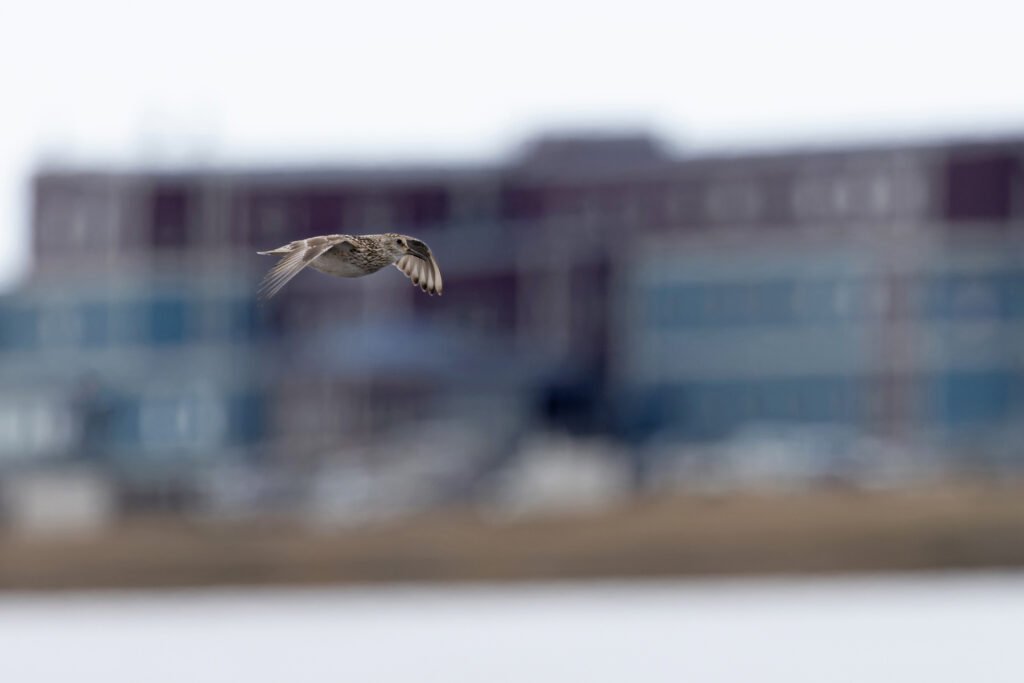
Baird’s Sandpiper on Top of the World (Image by Mike Watson)
It is likely that the shorebirds and waterfowl do so well here owing to the local people’s hatred and persecution of Arctic Foxes. They are shot on sight, thought to be a pest in town where folks dry meat in the open air. There was quite a lot of meat on the ice by the town, including bits of reindeer, which attracted Glaucous Gulls and on one occasion what we think is probably a Lesser Black-backed Gull of the Siberian form heuglini. Towards the end of our stay the weather deteriorated a little, with fog rolling in from the sea. We were happily clicking away while the wall of mist approached and then it was simply game over. Nothing could be done other than to take a much-needed break. The midnight sun was by far the best time of day to photograph birds, not in the middle of the night when activity tending to dip a little but on either side of it. During the day the heat shimmer made persistence a waste of time. We added a few new birds like Black Guillemot and snow goose but neither were photogenic and we spent a lot of time trying to get closer to Snowy Owls with varying success.
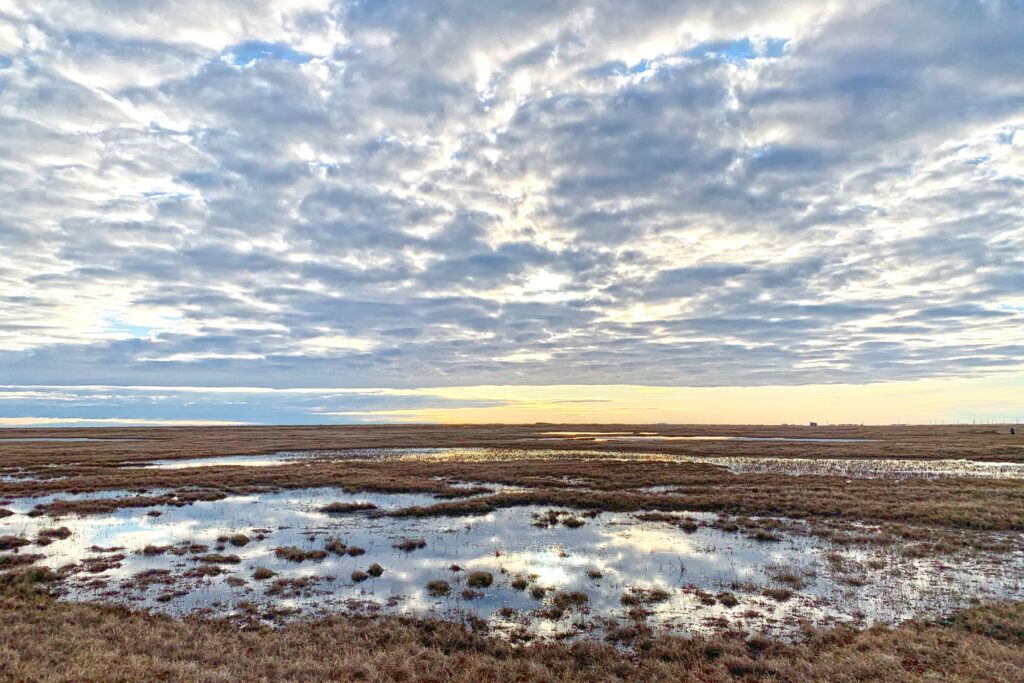
Midnight sun over the tundra pools at Utqiagvik (Image by Mike Watson)
On our final morning we had a lovely encounter with a pair of Red-necked Stints, which had taken up residence by some tiny tundra pools on the edge of town. They are essentially Siberian breeding birds, which cross the Bering Strait in small numbers to Alaska. Goodness me, they are feisty, those pesky Russians! Constantly seeing off the local Semipalmated Sandpipers. What gorgeous little, rufous-throated birds they are. We were all able to catch up with them, a grand way to sign off on the North Slope! As we left Utqiagvik we saw the preparations for Nalukataq, the blanket toss celebration, where the local community comes together to celebrate a successful spring whaling season. They have a quota to hunt 12 Bowhead Whales per year, which can be rolled over if they do not quite reach their quota. We also had a look around the very impressive Inupiat Heritage Center. It has a lot of whaling artefacts. I wouldn’t go out into the Arctic Ocean in an umiaq, the flimsy wooden whaling boat with sealskin covered hull, let alone attack a 80 ton animal in one!
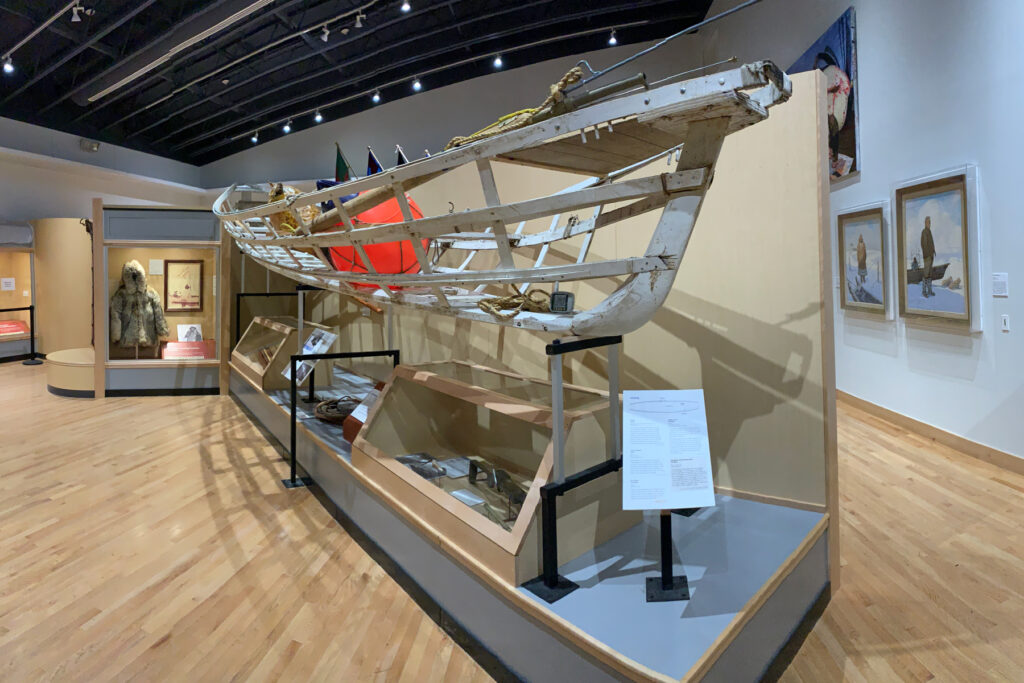
Inupiat Heritage Center, Utqiagvik (Image by Mike Watson)
SAINT PAUL, PRIBILOF ISLANDS
Back in Anchorage we prepared for the last leg of our Alaskan adventure saying goodbye to some of the group and welcoming our final guest. The flights to and from Saint Paul Island, 57 degrees north, in the Pribilof group do not always operate to plan, they run when weather allows, notably fog and mist. We were lucky that our outblound Ravn Air flight operated on time, stopping for a ‘squirt of fuel’ in remote Bethel before the little Dash 8 turbo-prop aircraft headed out into the Bering Sea. We were met off the flight by our highly capable St Paul Tours guides, Sulli, Luis and Mariah and, once we had collected our bags, we settled into our new surroundings, the King Eider Hotel, basically an annexe of the airport terminal. It was a quirky, yet lovely place to stay, and spotlessly clean! There had been a flurry of Siberian vagrants earlier in the week, including two rubythroats, but Sulli mentioned they hadn’t been seen this morning and with the weather due to deteriorate again we ought to head to the sea cliffs instead. After all, that is the main reason most birders visit Saint Paul. Our first port of call was Reef Point at the southern tip of the island. All the birds we were after can be found here, Saint Paul in miniature. We arrived to a steady flow of Tufted Puffin flight shot opportunities with smaller numbers of Horned Puffins, Parakeet Auklets, Red-faced Cormorants and Red-legged Kittiwakes. A great selection of Bering seabirds! There was only a couple remaining in the space of a few minutes! Pretty soon a few tiny Least Auklets flew by, leaving only Crested Auklet. The cliffs are low here, made of basalt (the whole island is or volcanic origin) and the onshore wind in the early evening certainly helped. We had our first peek at Northern Fur Seals from the small blind nearby as well as the Steller’s Sealions slumbering on the tiny islet just off the southern point, basically just cigar-shaped sandy lumps at this distance. A very nice session that remained the best flight shot opportunity of our stay on Saint Paul. Great call Sulli! The evening was atrocious and completely unphotographable. We staggered around the Northeast Point, site of one of the previous day’s rubythroats, in driving rain to no avail. Nice place though, fur seals stretching into the distance and waves crashing against the shore. Rock Sandpipers were scattered all the way there and a few Greater Scaups and Long-tailed Ducks were also noted. Glaucous-winged Gulls had replaced Glaucous Gulls at this lower latitude.
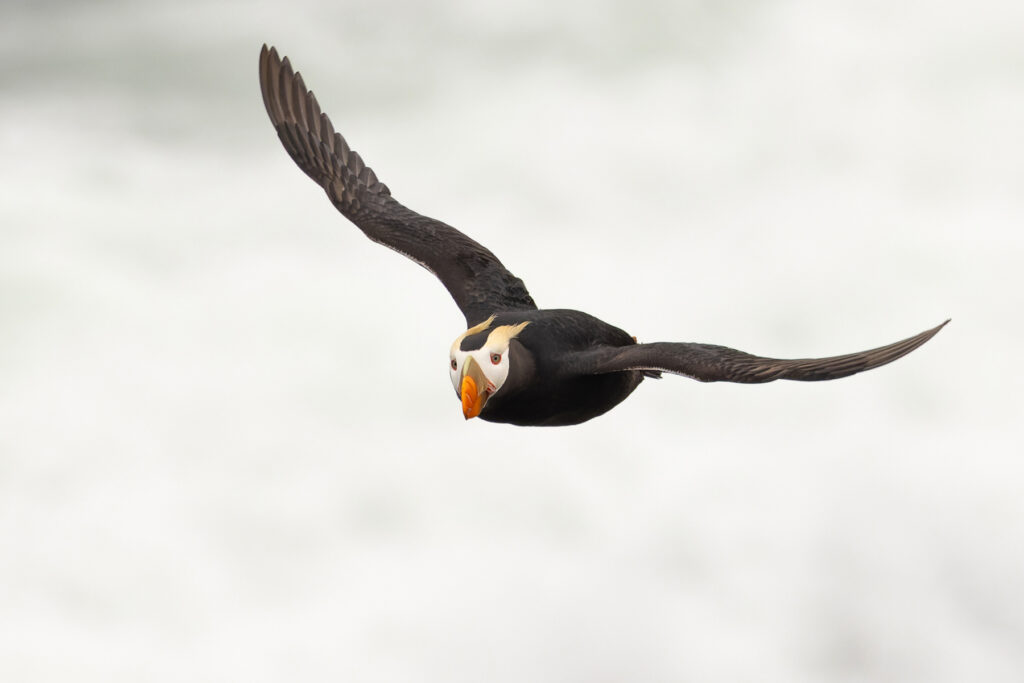
Tufted Puffin, Saint Paul Island (Image by Mike Watson)
The way to breakfast in the hotel took us along a long corridor with exposed plumbing, past former telephone booths, public conveniences, the airport gift shop, and airline check-in area to the very large canteen. Meals are flown in with each new group and our hosts put on a great spread each time. We shared the accommodation with a couple of engineers working on the weather station, which is crucial to the operation of flights. The mist can roll in quickly on Saint Paul! It can rain a lot too, in fact it rained on and off all day today. We made the best of the morning session at Reef Point, where the Crested Auklets obliged beautifully on the rocks just below us. They are an early morning event only and the light was not great but if there aren’t too main raindrops in the air, and we are close, then we can do something. Nothing beats a little sunshine, however. We could even manage some beak-open shots isolated on a nice rocky perch. Both Thick-billed and Common Murres were also on the cliffs, such variety among a relatively small group of birds. There weren’t any other photo opportunities today in the mist, as we explored more widely, along the coast to Antone Wall, Ridge Wall and Southwest Point. We saw some interesting birds today, a flock of around 200 Harlequin Ducks riding the surf and a single Rhinoceros Auklet distantly off Ridge Wall, rare at Saint Paul. There was also a hybrid Green-winged x Eurasian Teal drake, with both horizontal and vertical flank stripes!
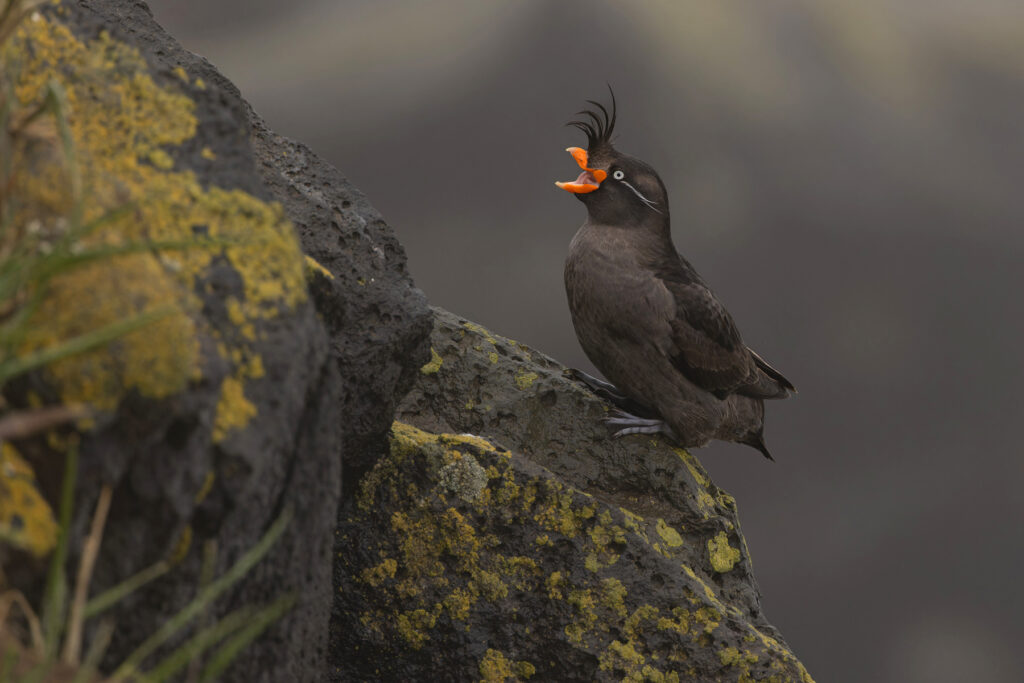
Crested Auklet, the most south-after alcid on Saint Paul Island (Image by Mike Watson)
The next morning started misty, with intermittent rain, clearing to sunny intervals by midday. A female King Eider offshore at Reef Point was new for our visit to Saint Paul, as were an adult Pomarine Jaeger with full spoons heading north and a pair of Ancient Murrelets, also quite distant and into the mist. We could enjoy a few Arctic plants in the mist, including the gorgeous blue flowers of Boreal Jacob’s Ladder, one of my favourites, as well as Rock Jasmine. When the weather improved, we enjoyed four excellent sessions. The first was THE Least Auklet experience at Antone Wall. There were small groups of the sparrow-sized auklets perched on the large, rounded boulders along the rocky beach, which flew off as we got closer, however, before too long they returned and eventually so did more, some landing around five metres away in lovely, filtered light. Fab-u-lous! We also had a great session with Red-legged Kittiwakes at one of their regular resting spots, they were rather approachable. I don’t think I have ever been able to approach a flock of resting gulls to less than five metres! We had the same views of Rock Sandpipers in the Salt Lagoon, with some excellent low angle shots possible of these Dunlin-a-likes. The last of these excellent sessions was with a smart breeding plumaged Curlew Sandpiper at Antone Slough, found by Sulli and Luis. This Siberian shorebird is a rare vagrant to anywhere in the USA! It had arrived in the company of a Western Sandpiper and allowed some very close approach, the flip screen on the Canon R5 coming into its own again! In the evening the fog rolled in again and the normal greyscale lighting service was resumed.
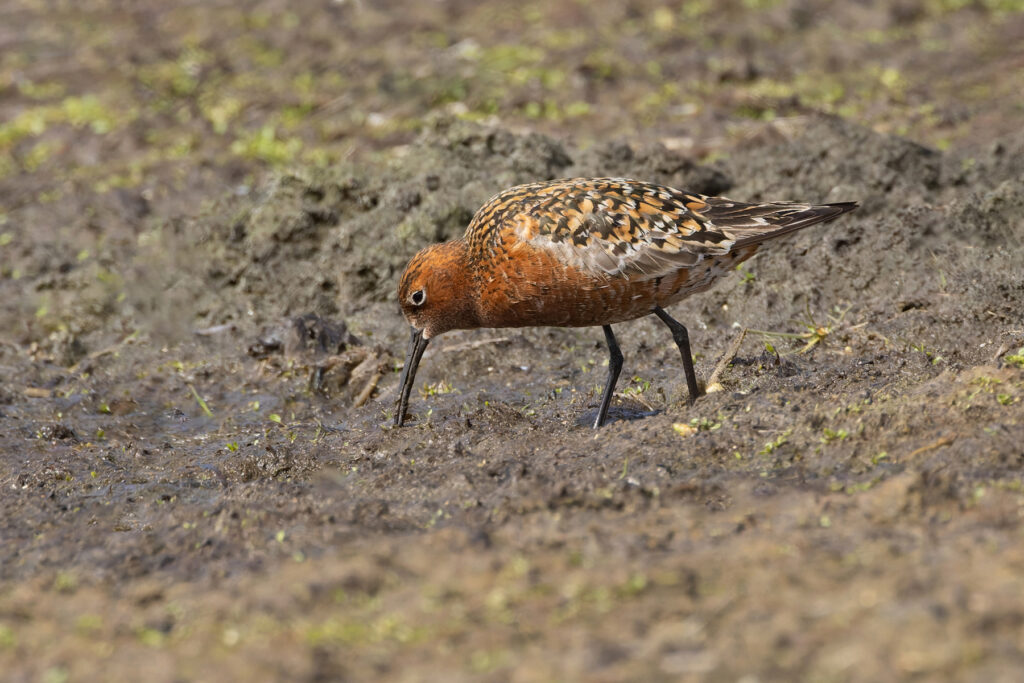
Curlew Sandpiper, in full breeding dress, a rare vagrant from Siberia (Image by Mike Watson)
It was still foggy when we woke next day and this continued for much of the day, with only a few sunny intervals in the evening. A young male King Eider was in the harbour and came over to look at us, while we chatted to Bill, the former manager of the mothballed Trident crab processing factory. This featured in the TV docusoap ‘The Deadliest Catch’, albeit without direct reference to Saint Paul. This is where the crabs caught out of Dutch Harbor were landed and processed. Disastrous news was that the 2023 halibut fishing season out of St Paul had just been cancelled, following the failure to have a functioning ice machine in the processing plant! The fish quota will still be fished but not by Saint Paul boats. This will represent a significant loss of income to the island. Antone Slough offered some good close views of Semipalmated Plover, Least Sandpiper, Long-tailed Duck, and a vagrant Cackling Goose of the tiny minima subspecies, although the light was still grim. The afternoon saw our best encounter on Saint Paul, a terrific view of a Tufted Puffin on High Bluff, located just over the cliff top by Sulli. A gap in the clouds appeared and shafts of sunlight positively lit up the most beautiful of auks. Wow! That was something. Then the fog and mist rolled in again and it was game over. The flora on the clifftop was interesting and there were a few Snow Buntings, Lapland Longspurs and Rock Sandpipers around. Things picked up in the evening and we had some nice views of Horned and Tufted Puffins at Ridge Wall. The Arctic Fox count reached eight today, they have dens up and down the coast, where they forage for food on the basalt rocky shore, the reason why the blue morph is predominant here, the reverse of almost all other parts of its range where they form only one percent of the population. One of our group, Richard, has a particular passion for them and spent many hours watching foxes on this trip. It was easy to drop him off near a den and pick him up some hours later!
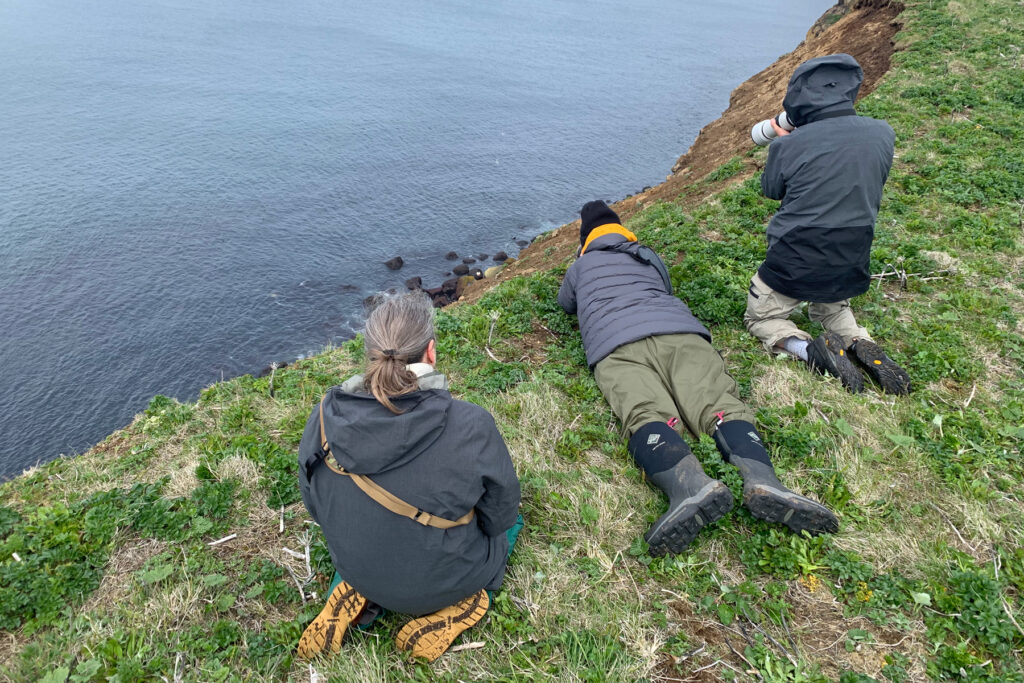
Wild Images guests shooting a Tufted Puffin at High Bluff on Saint Paul Island (Image by Mike Watson)
We went through the routine of checking out of the King Eider Hotel this morning, although we were pretty sure the plane from Anchorage would not be coming in the thick mist, which persisted all day. We toured the usual spots and added a couple of new ones. The north shore was interesting but did not offer anything new apart from a Double-crested Cormorant with the Red-faced and Pelagics. There was a steady passage of kittiwakes east along the coast and an Arctic Fox wandered along a deserted black sand beach, one of another eight today including two cubs under a container at the crab pots. A Wandering Tattler appeared on the Salt Lagoon and there were three drake King Eiders in the harbour mouth but all were out of range of the cameras. Some lovely Arctic Forget-me-nots on Black Diamond Hill, another lovely blue-flowered plant, were much appreciated and an obliging Short-eared Owl by the van towards Zapadni was also very co-operative. The plane never arrived today, and we got to spend an extra night on Saint Paul. We were keen to make the extra day count as the sky cleared in the evening!
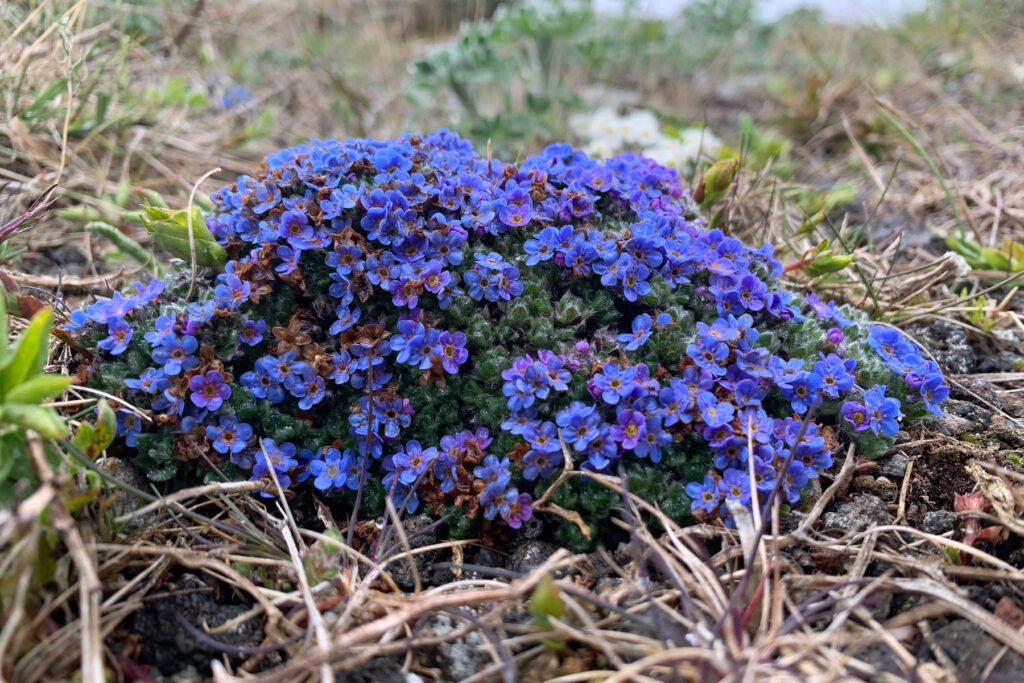
A cushion of the delightful Arctic Forget-me-not on Saint Paul Island (Image by Mike Watson)
The flight from Anchorage was going to make it today, the skies were almost clear, and we were able to improve our images of a couple of birds dramatically. The Cackling Goose was still at Antone Slough and obliged with some views on the ground and a couple of fly-bys in nice light. The Western Sandpiper was still here and obliging, however, the Curlew Sand proved to be a one-day wonder. First prize today went to some incredible views of Ancient Murrelets in the surf off Reef Point, so nice to see them like this! The auks at Reef Point were also pretty good today but there was not as much activity as on previous days. After checking in for our flight we had some time to kill. A US Coast Guard C130 Super Hercules plane landed, bringing an Admiral to Saint Paul and we chatted to the crew. They would have loved to see the Caribou herd but were worried about getting back in time. Well, they missed a rag tag band of around 150 Caribou, some with truly massive antlers, and a male Snowy Owl up near the radar station. The latter typically only a few pixels, miles away but still great to see here. Our adventure really had ended this time and we began to find the long way home. Thanks to everyone who helped to make this tour a success, particularly our enthusiastic group. We will be back in 2026.


































































































